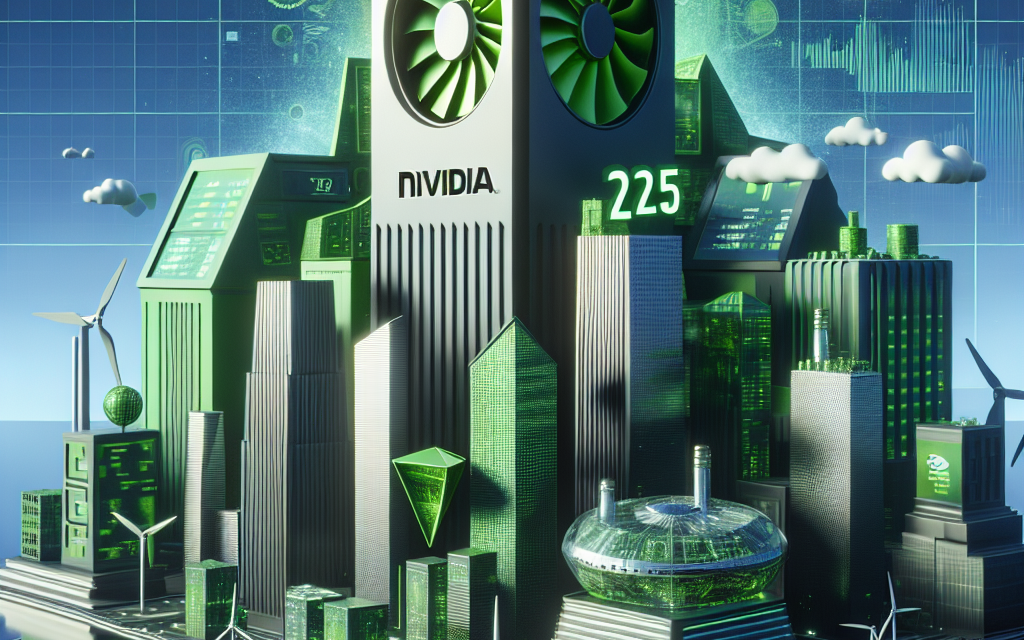“Nvidia: Powering Tomorrow’s Innovations—Can It Maintain Its Market Lead in 2025?”
Introduction
Nvidia has established itself as a dominant force in the technology sector, particularly in graphics processing units (GPUs) and artificial intelligence (AI) solutions. With a robust portfolio that includes gaming, data centers, and automotive applications, the company has consistently outperformed competitors and captured significant market share. As we look toward 2025, questions arise regarding Nvidia’s ability to sustain its success amidst evolving market dynamics, increasing competition, and technological advancements. This analysis will explore the factors contributing to Nvidia’s market dominance, potential challenges it may face, and the strategic initiatives that could influence its trajectory in the coming years.
Nvidia’s Competitive Edge in AI and Machine Learning
Nvidia has established itself as a formidable leader in the fields of artificial intelligence (AI) and machine learning, a position that has been bolstered by its innovative technologies and strategic market positioning. As the demand for AI-driven solutions continues to surge across various industries, Nvidia’s competitive edge becomes increasingly significant. The company’s success can be attributed to several key factors, including its advanced hardware, robust software ecosystem, and strategic partnerships, all of which contribute to its dominance in the market.
At the heart of Nvidia’s competitive advantage lies its cutting-edge graphics processing units (GPUs), which have evolved beyond their original purpose of rendering graphics for video games. Today, these GPUs are integral to the training and deployment of AI models, enabling faster processing and more efficient computations. The architecture of Nvidia’s GPUs, particularly the Ampere and Hopper architectures, has been specifically designed to handle the complex calculations required for deep learning and neural networks. This technological prowess allows Nvidia to outperform its competitors, making its products the preferred choice for researchers and developers in the AI space.
Moreover, Nvidia’s commitment to developing a comprehensive software ecosystem further enhances its competitive edge. The company has invested heavily in software frameworks such as CUDA, which allows developers to leverage the full power of its GPUs for parallel computing tasks. Additionally, Nvidia’s deep learning platform, including tools like TensorRT and the Nvidia Deep Learning SDK, provides users with the resources necessary to optimize their AI applications. This seamless integration of hardware and software not only simplifies the development process but also ensures that users can achieve optimal performance from their AI models, thereby solidifying Nvidia’s position as a leader in the industry.
In addition to its technological advancements, Nvidia has strategically aligned itself with key players in various sectors, including cloud computing, automotive, and healthcare. Partnerships with major cloud service providers such as Amazon Web Services and Microsoft Azure have enabled Nvidia to expand its reach and provide scalable AI solutions to a broader audience. Furthermore, collaborations with automotive manufacturers to develop AI-driven autonomous vehicle technologies showcase Nvidia’s versatility and adaptability in addressing the needs of different industries. These strategic alliances not only enhance Nvidia’s market presence but also foster innovation, as the company continues to explore new applications for its technology.
As we look toward 2025, the question arises: will Nvidia sustain its success in the rapidly evolving landscape of AI and machine learning? While the company currently enjoys a dominant position, it must remain vigilant against emerging competitors and technological advancements. The AI market is characterized by rapid innovation, and new players are continually entering the field, often with disruptive technologies that challenge established norms. To maintain its competitive edge, Nvidia will need to continue investing in research and development, ensuring that it stays at the forefront of technological advancements.
Furthermore, as ethical considerations and regulatory frameworks surrounding AI become more prominent, Nvidia will need to navigate these challenges effectively. By prioritizing responsible AI development and addressing concerns related to bias and transparency, the company can enhance its reputation and build trust with consumers and stakeholders alike. In conclusion, while Nvidia’s current market dominance in AI and machine learning is impressive, its ability to sustain this success will depend on its commitment to innovation, strategic partnerships, and ethical practices in the years leading up to 2025 and beyond.
The Impact of Gaming Industry Trends on Nvidia’s Growth
Nvidia’s market dominance in the technology sector, particularly in graphics processing units (GPUs), has been significantly influenced by the evolving trends within the gaming industry. As gaming continues to grow into a multi-billion-dollar global enterprise, Nvidia’s strategic positioning within this market has allowed it to capitalize on emerging opportunities. However, the sustainability of this success hinges on various factors, including technological advancements, consumer preferences, and competitive dynamics.
One of the most notable trends in the gaming industry is the increasing demand for high-performance graphics and immersive experiences. Gamers are continually seeking more realistic visuals and smoother gameplay, which has led to a surge in the adoption of advanced GPUs. Nvidia has consistently responded to this demand by innovating its product line, introducing cutting-edge technologies such as ray tracing and AI-enhanced graphics. These advancements not only enhance the gaming experience but also solidify Nvidia’s reputation as a leader in the GPU market. As the gaming community becomes more discerning, the expectation for superior graphics performance will likely continue to drive Nvidia’s growth.
Moreover, the rise of esports has transformed the gaming landscape, creating new revenue streams and expanding the audience for competitive gaming. Esports events attract millions of viewers and generate substantial advertising and sponsorship revenue. Nvidia has recognized this trend and has strategically aligned its products with the needs of professional gamers and streamers. By sponsoring esports tournaments and collaborating with game developers, Nvidia has positioned itself as an integral part of the esports ecosystem. This involvement not only enhances brand visibility but also fosters loyalty among gamers who rely on Nvidia’s technology to perform at their best.
In addition to traditional gaming, the increasing popularity of cloud gaming services presents both opportunities and challenges for Nvidia. As more gamers opt for streaming services that allow them to play high-quality games on various devices without the need for expensive hardware, Nvidia’s role in this space becomes crucial. The company has developed its own cloud gaming platform, GeForce NOW, which leverages its powerful GPUs to deliver high-performance gaming experiences remotely. However, the competitive landscape is intensifying, with other tech giants also investing heavily in cloud gaming. Nvidia must continue to innovate and enhance its offerings to maintain its competitive edge in this rapidly evolving market.
Furthermore, the integration of virtual reality (VR) and augmented reality (AR) into gaming is another trend that could significantly impact Nvidia’s growth trajectory. As these technologies become more mainstream, the demand for GPUs capable of rendering complex environments in real-time will increase. Nvidia’s ongoing research and development efforts in VR and AR technologies position it well to meet this demand. By providing the necessary hardware and software support for developers, Nvidia can ensure that it remains at the forefront of this burgeoning segment of the gaming industry.
In conclusion, while Nvidia’s current market dominance is largely attributed to its ability to adapt to gaming industry trends, the sustainability of its success will depend on its continued innovation and responsiveness to consumer needs. As the gaming landscape evolves, Nvidia must navigate the challenges posed by emerging technologies and increasing competition. By leveraging its strengths and maintaining a forward-thinking approach, Nvidia can not only sustain its success but also potentially expand its influence in the gaming industry through 2025 and beyond.
Nvidia’s Role in the Data Center Revolution
Nvidia has emerged as a pivotal player in the data center revolution, fundamentally transforming how organizations process and analyze vast amounts of data. As the demand for high-performance computing continues to surge, driven by advancements in artificial intelligence, machine learning, and big data analytics, Nvidia’s graphics processing units (GPUs) have become indispensable tools for enterprises seeking to harness the power of these technologies. The company’s innovative architecture, particularly the Ampere and Hopper series, has enabled unprecedented levels of parallel processing, allowing data centers to handle complex computations more efficiently than ever before.
Moreover, Nvidia’s strategic focus on developing software ecosystems, such as CUDA and TensorRT, has further solidified its position in the market. These platforms not only enhance the performance of Nvidia’s hardware but also provide developers with the necessary tools to optimize their applications for GPU acceleration. As a result, organizations are increasingly adopting Nvidia’s solutions to improve their operational efficiency and drive innovation. This trend is particularly evident in sectors such as healthcare, finance, and autonomous vehicles, where the ability to process large datasets in real-time is critical.
In addition to its hardware and software advancements, Nvidia has also made significant strides in establishing partnerships with major cloud service providers. By collaborating with companies like Amazon Web Services, Microsoft Azure, and Google Cloud, Nvidia has expanded its reach and made its technology more accessible to a broader range of customers. This strategic alignment not only enhances the scalability of Nvidia’s offerings but also positions the company as a key enabler of cloud-based AI and machine learning solutions. As organizations increasingly migrate their workloads to the cloud, Nvidia’s role in this transition cannot be overstated.
Furthermore, the rise of edge computing presents new opportunities for Nvidia to extend its influence in the data center landscape. As more devices become interconnected and generate vast amounts of data, the need for localized processing becomes paramount. Nvidia’s edge computing solutions, which leverage its powerful GPUs, allow organizations to analyze data closer to the source, reducing latency and improving response times. This capability is particularly crucial for applications such as real-time analytics, autonomous systems, and Internet of Things (IoT) devices, where immediate insights are essential for operational success.
However, as Nvidia continues to dominate the data center market, it faces increasing competition from other technology giants. Companies like AMD and Intel are investing heavily in their own GPU and AI solutions, aiming to capture a share of the rapidly growing market. Additionally, the emergence of specialized hardware designed for specific workloads poses a challenge to Nvidia’s traditional business model. To maintain its competitive edge, Nvidia must continue to innovate and adapt to the evolving landscape of data center technologies.
Looking ahead to 2025, the sustainability of Nvidia’s market dominance will largely depend on its ability to navigate these challenges while capitalizing on emerging trends. The ongoing evolution of AI and machine learning, coupled with the increasing importance of data-driven decision-making, suggests that the demand for Nvidia’s products and services will remain robust. However, the company must also be vigilant in addressing the competitive pressures that threaten its position. By fostering a culture of innovation and remaining responsive to market dynamics, Nvidia can not only sustain its success but also continue to play a leading role in shaping the future of the data center revolution.
Challenges from Emerging Competitors in the GPU Market
Nvidia has long been recognized as a leader in the graphics processing unit (GPU) market, a position it has maintained through continuous innovation and strategic investments. However, as the technology landscape evolves, emerging competitors are beginning to challenge Nvidia’s dominance, raising questions about the sustainability of its success in the coming years, particularly as we approach 2025. The rise of new players in the GPU market is not merely a matter of competition; it signifies a shift in the dynamics of the industry, driven by advancements in technology and changing consumer demands.
One of the most significant challenges to Nvidia’s market position comes from companies like AMD and Intel, which have made substantial strides in developing their own GPU architectures. AMD, with its Radeon series, has been particularly aggressive in targeting both the gaming and professional markets. The introduction of its RDNA architecture has allowed AMD to offer competitive performance at more attractive price points, thereby appealing to budget-conscious consumers and gamers. This competitive pricing strategy has the potential to erode Nvidia’s market share, especially among those who prioritize value over brand loyalty.
Moreover, Intel’s entry into the discrete GPU market with its Arc series has added another layer of complexity to the competitive landscape. Although Intel is still in the early stages of establishing its presence, its vast resources and expertise in semiconductor manufacturing could enable it to develop GPUs that rival Nvidia’s offerings. As Intel continues to refine its technology and expand its product lineup, it poses a credible threat to Nvidia’s long-standing supremacy.
In addition to traditional competitors, the emergence of specialized companies focusing on artificial intelligence (AI) and machine learning (ML) applications is reshaping the GPU market. Firms like Graphcore and Cerebras Systems are developing accelerators specifically designed for AI workloads, which could divert demand away from Nvidia’s general-purpose GPUs. As industries increasingly adopt AI technologies, the need for tailored solutions may lead to a shift in preference towards these specialized products, challenging Nvidia’s ability to maintain its market share.
Furthermore, the rapid evolution of cloud computing and the growing demand for GPU resources in data centers present both opportunities and challenges for Nvidia. While the company has made significant inroads into the cloud market with its A100 and H100 GPUs, competition from cloud service providers developing their own custom chips could threaten Nvidia’s position. Companies like Amazon and Google are investing heavily in proprietary silicon, which could lead to a reduction in reliance on Nvidia’s products for cloud-based applications.
As Nvidia navigates these challenges, it must also contend with the broader economic environment, which can impact consumer spending and investment in technology. Economic downturns or shifts in consumer preferences could affect the demand for high-performance GPUs, particularly in the gaming sector, where discretionary spending is often the first to be curtailed. Additionally, supply chain disruptions and geopolitical tensions may further complicate Nvidia’s ability to deliver products efficiently, potentially hindering its growth trajectory.
In conclusion, while Nvidia has established itself as a formidable player in the GPU market, the landscape is becoming increasingly competitive. The emergence of new rivals, coupled with shifts in technology and consumer behavior, poses significant challenges to Nvidia’s market dominance. As we look toward 2025, the company’s ability to adapt to these changes and innovate in response to emerging threats will be crucial in determining whether it can sustain its success in an evolving industry.
The Future of Nvidia’s Product Innovations
Nvidia has established itself as a leader in the technology sector, particularly in the fields of graphics processing units (GPUs) and artificial intelligence (AI). As we look toward 2025, the question arises: will Nvidia sustain its success through continued product innovations? To answer this, it is essential to examine the company’s current trajectory, its commitment to research and development, and the broader market trends that may influence its future.
At the core of Nvidia’s success is its ability to innovate consistently. The company has a robust portfolio of products that cater to various sectors, including gaming, data centers, and automotive technology. The introduction of the Ampere architecture marked a significant leap in performance and efficiency, setting new standards for GPU capabilities. As gaming and AI applications become increasingly demanding, Nvidia’s focus on enhancing its hardware to meet these needs will be crucial. The anticipated release of next-generation GPUs, which promise even greater performance and energy efficiency, is expected to solidify Nvidia’s position in the market.
Moreover, Nvidia’s foray into AI and machine learning has opened new avenues for growth. The company’s GPUs are not only used for rendering graphics but also for training complex AI models. This dual functionality has positioned Nvidia as a key player in the AI revolution, which is projected to expand significantly in the coming years. As industries increasingly adopt AI technologies, Nvidia’s ability to innovate in this space will be vital. The development of specialized hardware, such as the Tensor Core GPUs, demonstrates Nvidia’s commitment to optimizing its products for AI workloads, thereby enhancing its competitive edge.
In addition to hardware innovations, Nvidia is also investing in software solutions that complement its products. The launch of the Nvidia Omniverse platform, which facilitates collaboration in 3D design and simulation, exemplifies the company’s strategy to create an ecosystem around its hardware. By providing developers with tools that enhance productivity and creativity, Nvidia not only strengthens customer loyalty but also encourages the adoption of its GPUs across various applications. This holistic approach to product development is likely to yield dividends as more industries recognize the value of integrated solutions.
Furthermore, Nvidia’s strategic partnerships and acquisitions play a significant role in its innovation strategy. Collaborations with leading tech companies and research institutions enable Nvidia to stay at the forefront of emerging technologies. For instance, partnerships in the automotive sector aim to advance autonomous driving capabilities, while collaborations in the healthcare field focus on leveraging AI for medical diagnostics. These alliances not only enhance Nvidia’s technological capabilities but also expand its market reach, ensuring that the company remains relevant in an ever-evolving landscape.
However, it is essential to consider the competitive environment in which Nvidia operates. As other companies invest heavily in GPU technology and AI, Nvidia must continue to differentiate itself through innovation. The rise of competitors, particularly in the semiconductor industry, poses a challenge that could impact Nvidia’s market share. Therefore, maintaining a relentless focus on research and development will be critical for Nvidia to sustain its leadership position.
In conclusion, while the future of Nvidia’s product innovations appears promising, the company must navigate a complex landscape of competition and technological advancement. By continuing to invest in cutting-edge hardware and software solutions, fostering strategic partnerships, and adapting to market demands, Nvidia is well-positioned to sustain its success through 2025 and beyond. The interplay of these factors will ultimately determine whether Nvidia can maintain its dominance in the rapidly evolving tech industry.
Market Predictions: Nvidia’s Stock Performance in 2025
Nvidia has established itself as a powerhouse in the technology sector, particularly in the fields of graphics processing units (GPUs) and artificial intelligence (AI). As we look ahead to 2025, market predictions regarding Nvidia’s stock performance are influenced by several key factors, including industry trends, competitive dynamics, and the company’s strategic initiatives. Analysts are closely monitoring these elements to gauge whether Nvidia can maintain its current trajectory of growth and profitability.
One of the primary drivers of Nvidia’s success has been the surging demand for GPUs, particularly in gaming, data centers, and AI applications. The gaming industry continues to expand, with more consumers seeking high-performance graphics for an immersive experience. This trend is expected to persist, bolstered by the rise of virtual reality and augmented reality technologies. Consequently, Nvidia’s gaming segment is likely to remain a significant contributor to its revenue, providing a solid foundation for stock performance in 2025.
In addition to gaming, the demand for AI and machine learning capabilities is rapidly increasing across various sectors, including healthcare, finance, and autonomous vehicles. Nvidia’s GPUs are integral to training AI models, making the company a critical player in this burgeoning market. As businesses increasingly adopt AI technologies, Nvidia stands to benefit from a growing customer base, which could further enhance its stock performance. Analysts predict that if Nvidia continues to innovate and expand its AI offerings, it could solidify its position as a leader in this space, thereby driving investor confidence.
However, Nvidia’s market dominance is not without challenges. The competitive landscape is evolving, with other technology companies, such as AMD and Intel, making significant strides in GPU development. These competitors are not only enhancing their product offerings but also vying for market share in the AI domain. As competition intensifies, Nvidia may face pressure to maintain its pricing power and market share. Investors will need to consider how effectively Nvidia can navigate this competitive environment while continuing to deliver innovative products.
Moreover, geopolitical factors and supply chain disruptions could impact Nvidia’s operations and stock performance. The ongoing tensions between the United States and China, for instance, have raised concerns about potential restrictions on technology exports. Such developments could hinder Nvidia’s ability to access key markets or source essential components, ultimately affecting its revenue growth. Investors will be keenly aware of these risks as they assess Nvidia’s prospects for 2025.
Despite these challenges, Nvidia’s strong financial position and commitment to research and development provide a buffer against potential setbacks. The company has consistently demonstrated its ability to adapt to changing market conditions and consumer preferences. By investing in new technologies and expanding its product portfolio, Nvidia is well-positioned to capitalize on emerging opportunities. This proactive approach could bolster investor sentiment and support a positive outlook for its stock performance in 2025.
In conclusion, while Nvidia’s market dominance is currently robust, its future stock performance will depend on a myriad of factors, including industry trends, competitive pressures, and geopolitical dynamics. As the company continues to innovate and respond to market demands, it is likely to remain a focal point for investors. Ultimately, the ability of Nvidia to sustain its success will hinge on its strategic decisions and adaptability in an ever-evolving technological landscape. As we approach 2025, stakeholders will be watching closely to see how these elements unfold and influence Nvidia’s trajectory in the market.
Regulatory Challenges and Their Potential Impact on Nvidia’s Dominance
Nvidia has established itself as a powerhouse in the technology sector, particularly in the fields of graphics processing units (GPUs) and artificial intelligence (AI). However, as the company continues to expand its influence and market share, it faces a myriad of regulatory challenges that could significantly impact its dominance in the coming years. These challenges stem from various sources, including antitrust scrutiny, international trade policies, and evolving data privacy regulations. Understanding these factors is crucial for assessing Nvidia’s potential trajectory as it approaches 2025.
One of the most pressing concerns for Nvidia is the increasing scrutiny from regulatory bodies regarding antitrust practices. As the company has grown, so too has the concern that it may be engaging in anti-competitive behavior. This scrutiny is not limited to Nvidia alone; it reflects a broader trend in the tech industry, where regulators are becoming more vigilant in monitoring the activities of major players. For instance, Nvidia’s acquisition strategies, particularly its attempted purchase of Arm Holdings, have raised alarms about market concentration and the potential stifling of competition. If regulators decide to impose restrictions or block such acquisitions, Nvidia may find its growth trajectory hindered, limiting its ability to innovate and expand its product offerings.
In addition to antitrust issues, Nvidia must navigate the complexities of international trade policies. The geopolitical landscape is continually shifting, with trade tensions between major economies such as the United States and China posing significant risks. Nvidia relies heavily on global supply chains for its manufacturing processes, and any disruptions caused by tariffs or trade restrictions could adversely affect its operations. Furthermore, as countries implement stricter export controls on advanced technologies, Nvidia may face challenges in accessing critical markets or components necessary for its products. Such obstacles could impede its ability to maintain its competitive edge and meet the growing demand for AI and GPU technologies.
Moreover, evolving data privacy regulations present another layer of complexity for Nvidia. As governments worldwide implement stricter data protection laws, companies must adapt their practices to comply with these regulations. Nvidia’s products are increasingly integrated into systems that handle vast amounts of data, making it imperative for the company to ensure that it adheres to these legal frameworks. Failure to comply could result in hefty fines and damage to its reputation, which could, in turn, affect customer trust and loyalty. As consumers become more aware of data privacy issues, their preferences may shift, compelling Nvidia to innovate not only in technology but also in how it manages and protects user data.
Despite these regulatory challenges, Nvidia’s strong market position and commitment to innovation may provide a buffer against potential setbacks. The company has consistently demonstrated its ability to adapt to changing market conditions and regulatory environments. By investing in research and development, Nvidia can continue to lead in AI and GPU technologies, potentially mitigating the impact of regulatory hurdles. Furthermore, proactive engagement with regulators and policymakers could help Nvidia navigate the complexities of compliance while advocating for favorable conditions within the industry.
In conclusion, while Nvidia’s market dominance is currently robust, the regulatory challenges it faces could significantly influence its success as it approaches 2025. Antitrust scrutiny, international trade policies, and evolving data privacy regulations all pose potential risks that could impact its operations and growth. However, Nvidia’s history of innovation and adaptability may enable it to sustain its success, provided it effectively addresses these challenges and continues to engage with the regulatory landscape. The coming years will be critical in determining whether Nvidia can maintain its leadership position in an increasingly complex and regulated environment.
Q&A
1. **Question:** What factors contribute to Nvidia’s current market dominance?
**Answer:** Nvidia’s dominance is driven by its leadership in GPU technology, strong demand in gaming, data centers, AI, and machine learning applications, as well as strategic partnerships and acquisitions.
2. **Question:** How does Nvidia’s product innovation impact its market position?
**Answer:** Continuous product innovation, such as advancements in GPU architecture and AI capabilities, helps Nvidia maintain a competitive edge and attract a broad customer base.
3. **Question:** What role does competition play in Nvidia’s market sustainability?
**Answer:** Increased competition from companies like AMD and Intel could challenge Nvidia’s market share, but its established brand and technology leadership may help it fend off rivals.
4. **Question:** How important is the AI market for Nvidia’s future success?
**Answer:** The AI market is crucial for Nvidia’s future, as its GPUs are widely used in AI training and inference, positioning the company to benefit from the growing demand for AI solutions.
5. **Question:** What are the potential risks to Nvidia’s market dominance by 2025?
**Answer:** Potential risks include supply chain disruptions, regulatory challenges, technological obsolescence, and shifts in consumer preferences that could impact demand.
6. **Question:** How does Nvidia’s financial performance influence its market position?
**Answer:** Strong financial performance allows Nvidia to invest in R&D, marketing, and strategic acquisitions, reinforcing its market position and ability to innovate.
7. **Question:** Will Nvidia’s current strategies be sufficient to sustain its success in 2025?
**Answer:** If Nvidia continues to innovate, adapt to market changes, and effectively leverage its strengths in AI and gaming, it is likely to sustain its success through 2025.
Conclusion
Nvidia’s market dominance is likely to sustain through 2025 due to its strong position in key growth sectors such as artificial intelligence, gaming, and data centers. The company’s continuous innovation, strategic partnerships, and expansion into new markets, coupled with increasing demand for high-performance computing, suggest that it will maintain its competitive edge. However, potential challenges from emerging competitors and market fluctuations could impact its trajectory. Overall, Nvidia’s robust business model and technological leadership position it well for continued success.





